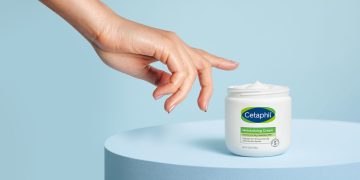Exfoliation is one of the cornerstones of a healthy skincare routine. But like many good things, too much of it can backfire. So, how often should you exfoliate without damaging your skin? The answer isn’t a simple “one-size-fits-all.” It depends on several factors, including your skin type, the exfoliation method you choose, and the products you use. Let’s break it down to understand the perfect balance.
Table of Contents
- What is Exfoliation?
- Why Is Exfoliation Important?
- Different Types of Exfoliation
- Physical Exfoliation
- Chemical Exfoliation
- How Often Should You Exfoliate?
- Signs You’re Over-Exfoliating
- Exfoliation Tips for Different Skin Types
- Exfoliation and Skin Sensitivity
- Common Mistakes to Avoid
- Conclusion
- Related Image Keywords
1. What is Exfoliation?
Exfoliation refers to the process of removing dead skin cells from the surface of your skin. This helps reveal fresh, newer skin underneath, keeping your skin smooth and radiant. Over time, dead skin cells can accumulate, leading to clogged pores, dullness, and uneven texture. Exfoliating regularly ensures that your skin is in its best condition and helps other skincare products penetrate deeper.
2. Why Is Exfoliation Important?
Dead skin cells accumulate on the skin’s surface naturally as part of the skin renewal process. However, when these cells aren’t removed, they can clog pores, contributing to acne, blackheads, and uneven skin tone. Regular exfoliation helps keep your skin clear, improves texture, and brightens your complexion.
Additionally, exfoliation increases blood flow, which can stimulate collagen production. Collagen is the protein responsible for skin elasticity and firmness. By exfoliating, you encourage a more youthful appearance over time.
3. Different Types of Exfoliation
Exfoliation can be broadly categorized into two types: physical and chemical exfoliation. Both methods help in removing dead skin cells, but they do so in different ways.

Physical Exfoliation
Physical exfoliation involves manually scrubbing your skin with gritty particles like sugar, salt, or microbeads. While it provides an immediate, visible result, it can be harsh on the skin if done too frequently. Overuse can cause microtears, leading to irritation and sensitivity.
Chemical Exfoliation
Chemical exfoliation uses active ingredients like AHAs (Alpha Hydroxy Acids), BHAs (Beta Hydroxy Acids), or enzymes to dissolve the bonds between dead skin cells, allowing them to shed more easily. Common ingredients include glycolic acid, salicylic acid, and lactic acid. Chemical exfoliants tend to be gentler than physical scrubs and can provide deeper exfoliation. However, they can increase your skin’s sensitivity, so proper usage is essential.
4. How Often Should You Exfoliate?
Now for the most important question—how often should you exfoliate your skin? The answer depends on several factors:
- Skin Type: Your skin type plays a crucial role in determining how often you should exfoliate.
- Oily skin can generally tolerate more frequent exfoliation, up to 3-4 times a week, since excess oil may cause more buildup of dead skin cells.
- Dry skin requires less frequent exfoliation, usually 1-2 times a week, to avoid over-drying and irritation.
- Combination skin can be exfoliated 2-3 times a week, focusing more on oil-prone areas.
- Sensitive skin needs extra care. Stick to once a week with mild exfoliants and avoid harsh scrubs or high concentrations of acids.
- Exfoliant Type: The type of exfoliant you use also influences frequency. For example, chemical exfoliants, particularly those with AHAs and BHAs, may be stronger and more effective with fewer applications. Physical exfoliants with coarse particles, on the other hand, should be used sparingly.
- Product Strength: If you’re using stronger exfoliating products (such as high-concentration acids), you should exfoliate less frequently, around once a week. Lighter, gentler products allow for more frequent use.
As a general rule, it’s best to start slow and adjust based on how your skin responds. Too much exfoliation can strip away natural oils and cause damage, while too little may prevent your skin from reaching its full potential.
5. Signs You’re Over-Exfoliating
It’s easy to get carried away with exfoliating, but overdoing it can cause more harm than good. Here are some signs that you’re exfoliating too often:
- Redness and irritation: Your skin may feel raw or inflamed.
- Dry patches or tightness: Excess exfoliation can strip the skin of its natural moisture barrier.
- Increased breakouts: Over-exfoliation can make your skin produce more oil, leading to clogged pores and acne.
- Peeling skin: Excessively exfoliating can cause your skin to peel or flake.
- Sensitivity: Your skin might become more sensitive to products, sunlight, and changes in temperature.
If you notice any of these signs, it’s time to dial back on exfoliation. Incorporate soothing ingredients like aloe vera, chamomile, and hyaluronic acid to restore your skin’s moisture balance.
6. Exfoliation Tips for Different Skin Types

For Oily Skin
- Exfoliate 3-4 times a week with a BHA (such as salicylic acid) to penetrate pores and reduce oil buildup.
- Look for gel-based exfoliants to prevent excess moisture loss.
For Dry Skin
- Exfoliate 1-2 times a week with AHAs (like glycolic or lactic acid), which help hydrate the skin while sloughing off dead cells.
- Avoid physical scrubs, as they can exacerbate dryness and irritation.
For Combination Skin
- Exfoliate 2-3 times a week, alternating between AHA and BHA exfoliants, to balance the oily T-zone while taking care of drier areas.
For Sensitive Skin
- Exfoliate once a week using a mild enzyme-based exfoliant or a very low concentration of AHAs.
- Consider using a lactic acid product, as it’s generally gentler on sensitive skin.
7. Exfoliation and Skin Sensitivity
If you have sensitive skin or conditions like rosacea, eczema, or psoriasis, you need to be extra cautious with exfoliation. Over-exfoliation can lead to flare-ups, irritation, and skin damage.
- Patch Test: Before applying an exfoliant to your entire face, test it on a small area to see how your skin reacts.
- Opt for Enzymatic Exfoliants: These are usually gentler than acids or scrubs and work by breaking down dead skin cells without physical abrasion.
- Consult a Dermatologist: If you have a skin condition, it’s best to seek professional advice to determine the best exfoliation regimen for your needs.
8. Common Mistakes to Avoid
- Using Harsh Scrubs: Physical exfoliants like walnut scrubs can cause microtears in the skin, leading to irritation.
- Exfoliating Too Frequently: Daily exfoliation can strip your skin’s natural oils, causing dryness and sensitivity.
- Exfoliating on Broken Skin: If you have cuts, acne, or irritated areas, avoid exfoliating to prevent further damage.
- Skipping Sunscreen: Exfoliating makes your skin more sensitive to the sun. Always follow up with sunscreen to prevent sun damage and premature aging.
9. Conclusion
Exfoliation is a powerful tool in your skincare routine, but like any tool, it requires proper handling. Striking the right balance is key—over-exfoliating can be as harmful as under-exfoliating. By considering your skin type, choosing the right exfoliant, and exfoliating at the appropriate frequency, you can achieve smoother, clearer, and more radiant skin.
Remember, exfoliation is just one step in a comprehensive skincare routine. Always follow up with hydration, moisturization, and sun protection to keep your skin healthy and glowing.












































